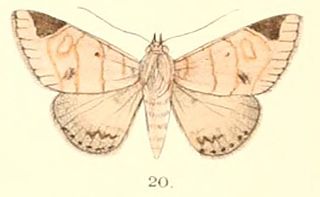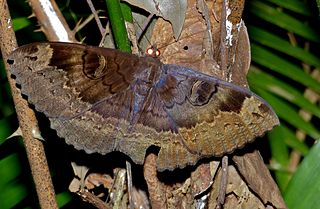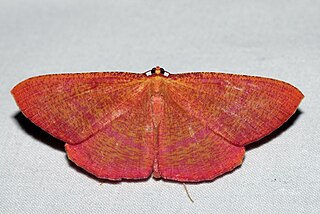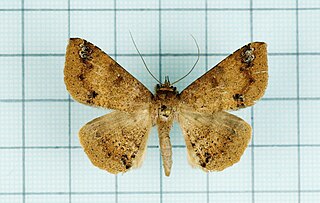
Erebus macrops is a species of moth of the family Erebidae first described by Carl Linnaeus in 1768. It is found in the subtropical regions of Africa and Asia. The wingspan is about 12 cm, making it exceptionally large for an Erebidae species. The larvae feed on Acacia and Entada species.

Dordura is a monotypic moth genus of the family Noctuidae erected by Frederic Moore in 1882. Its only species, Dordura aliena, was first described by Francis Walker in 1865. It is found in the Indian subregion, Sri Lanka, Myanmar, Thailand, Peninsular Malaysia, Sumatra, Borneo and New Guinea.

Erebus caprimulgus is a moth of the family Erebidae. It is found from the Oriental Region of India, Sri Lanka, Myanmar to Peninsular Malaysia, Sumatra and Borneo.

Eumelea rosalia is a species of moth of the family Geometridae described by Caspar Stoll in 1781. It is found from the Indo-Australian tropics of India, Sri Lanka, Myanmar, east to northern Australia and New Caledonia.

Chilo suppressalis, the Asiatic rice borer or striped rice stemborer, is a moth of the family Crambidae. It is a widespread species, known from India, Sri Lanka, China, eastern Asia, Japan, Taiwan, Malaysia to the Pacific.

Ambulyx substrigilis, the dark-based gliding hawkmoth, is a species of moth of the family Sphingidae. It was described by John O. Westwood in 1847.

Ericeia inangulata, the sober tabby, is a moth in the family Erebidae. The species was first described by Achille Guenée in 1852. It is found in the Indo-Australian tropics of China, India, Sri Lanka, Myanmar, and the Marianas and Carolines, Fiji, Vanuatu, New Caledonia and Samoa.
Somatina purpurascens is a moth of the family Geometridae first described by Frederic Moore in 1887. It is found in Sri Lanka.

Asura arcuata is a moth of the family Erebidae. It was described by Frederic Moore in 1882. It is found in India, Indonesia, Taiwan and Japan.
Asura rubricosa is a moth of the family Erebidae. It is found in India and Sri Lanka.
Asura floccosa is a moth of the family Erebidae. It is found in India and Sri Lanka.
Asura ila is a moth of the family Erebidae. It is found in India and Sri Lanka.
Asura ruptifascia is a moth of the family Erebidae. It is found in India and Sri Lanka.
Asura semifascia is a moth of the family Erebidae. It is found in Sri Lanka and Myanmar.
Asura varians is a moth of the family Erebidae. It is found in Sri Lanka.

Isturgia catalaunaria is a moth of the family Geometridae first described by Achille Guenée in 1858.
Spilarctia castanea is a moth in the family Erebidae. It was described by George Hampson in 1893. It is found in Sri Lanka.
Hypopyra unistrigata is a moth of the family Erebidae first described by Achille Guenée in 1852. It is found in China, India, Bangladesh, Sri Lanka (Trincomalee) and Cambodia.
Eupterote acesta is a moth in the family Eupterotidae. It was described by Charles Swinhoe in 1894. It is found in Thailand and India.
Eupterote harmani is a moth in the family Eupterotidae. It was described by Jeremy Daniel Holloway in 1987. It is found on Borneo. The habitat consists of hill dipterocarp and upper montane forests.







